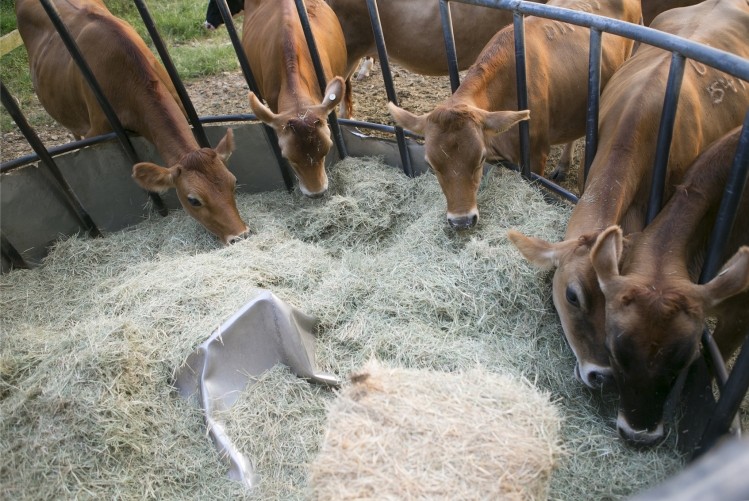China: Can invasive weed become cattle chow?

A team of Chinese researchers examined the use of the halophyte Spartina alterniflora (SA) in multiple plant stages as a forage inclusion in the diets of dairy cattle. The group reported their results in the journal Ecological Engineering.
“This study aims to (i) investigate nutritive values and mineral contents of S. alterniflora in different stages of maturity and in diets with different S. alterniflora inclusion levels; (ii) assess the effect of using graded levels of S. alterniflora as dietary inclusions on feed intake, voluntary water intake, and ruminal fermentation in dairy cattle; and (iii) evaluate the strengths and weaknesses of the use of S. alterniflora in ruminant production and subsequently provide systematic data on the feeding of this unconventional halophyt,” said the researchers.
Team members found that the plant in jointing, heading and flowering stages can be used as an ingredient in dairy cattle diets, and may offer a sustainable, alternative feed ingredient.
“The initial findings obtained from the feed and rumen fermentation analysis of dairy cattle demonstrate that S. alterniflora can be utilized as potential forage for dairy cattle at less than 25% of the animal’s diet,” said the researchers. “Overall, S. alterniflora could be provided with the potential to improve the sustainability of ruminant production as alternative feeds to replace partially common roughages, alleviate feeding cost and partially control the rapid spread of the invasive plant in salt marsh of China.”
Why alternative forages?
Chinese demand for milk has increased in recent years leading to intensified dairy production in coastal areas, said the researchers. Roughage for cattle diets has been predominately comprised of maize silage and hay.
But amounts of roughage ingredients do not meet current demand and are causing prices to increase, they said. Alternative feed ingredients are needed to bring down prices.
Halophytes are a species of drought-resistant plant with the ability to grow in saline and alkaline soils, they said. SA is a saltmarsh grass from North America that was introduced in China to control erosion.
“Given its enormous seed production and root fragments, S. alterniflora has adapted well and spread rapidly over the last 30 years in intertidal flats along the coastal regions of China, including Jiangsu, Shanghai, Zhejiang, and Fujian,” said the researchers. “In Jiangsu Province, S. alterniflora saltmarshes amounted to 15,000 ha in 2004 (Liu et al., 2007).”
The plant has been explored for use in fish feed, biomineral liquid and biofuel, they said. Little is known about its value as a feedstuff for ruminants, although a past study found it did not alter milk production or composition in dairy cattle.
The plant also can contain large concentrations of minerals, including salt (NaCL), in the stem and leaves, they said. But, little is known about the details of the plant’s nutritive value during different maturity levels.
The study
In the experiments, samples of the plant in seven life stages were collected and analyzed, said the researchers. Additionally, four diets were generated including 0%, 5%, 15%, or 25% SA replacing maize silage and wildrye hay.
Test diets were fed to late-lactating dairy cattle with ruminal cannulas in a 4x4 Latin square experimental design, they said. Each diet was fed in 18-day periods, with 15 days of feeding and three days of rumen liquid collection.
Feed intake was calculated, water intake was measured in the dietary tests and samples of ruminal fluid were collected for pH testing, they said.
Plant samples from the different maturity stages also were analyzed, said researchers.
Results
Examination of the plant in different life stages found that levels of crude protein (CP), ash content and dry matter (DM) digestion degraded as the plant maturity increased, said the researchers. But, biomass, DM, neutral detergent fiber (NFD) content and the acid detergent fiber (ADF) increased with plant age.
Mineral composition also altered during plant growing stages, they said. “Compared with conventional diets, S. alterniflora mixed diets showed higher ash, NDF, ADF, ether extract [EE], and Na, Ca [calcium], and P [phosphorus] contents, and similar organic matter (OM), CP, and gross energy contents,” added the researchers.
“The concentration of most minerals in S. alterniflora hay was the highest in stage 1,” they said. “Na [sodium] concentration initially increased and then decreased with maturity; it showed high concentrations in stages 3, 4, and 5.”
Calcium (Ca) and magnesium levels were similar through all growing stages, said the researchers. Phosphorus (P) levels were highest at stage 2, but decreased through maturity as did copper (Cu), iron (Fe), and zinc (Zn).
Water and dry matter intake increased when more SA was included in their diet, said the researchers. However, the molar percentage of acetate, propionate, butyrate, and isobutyrate along with the acetate: propionate ratio did not change.
The replacement level had no effect on crude protein or GE, they said. But amounts of EE, NDF and ADF increased with higher inclusion levels.
Ash levels increased with diets including more than 5% of the SA, and sodium levels increased linearly with added SA, they said.
“Ca and P concentration slightly increased, whereas Ca/P exhibited no significant change with increasing inclusion amount of S. alterniflora mixed in diets,” they said. “Cu content decreased, whereas Fe, K [potassium], Mg, and Zn showed no significant change, with increasing inclusion amount of S. alterniflora.”
No effect on ruminal pH was found, they added.
Source: Ecological Engineering
Title: Potential use of Spartina alterniflora as forage for dairy cattle
DOI: doi:10.1016/j.ecoleng.2016.03.035
Authors: Fengfei Qin, Boping Tang, Huanshi Zhang, Chuanyan Shi, Wenzong Zhou, Liren Ding, Pei Qin,











